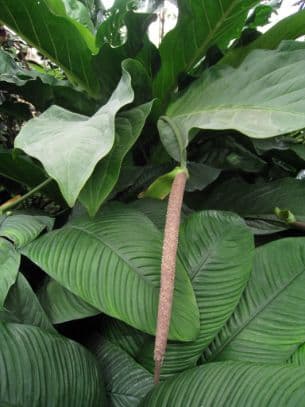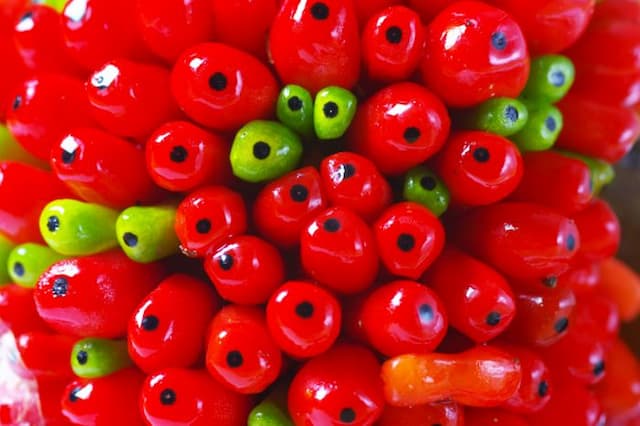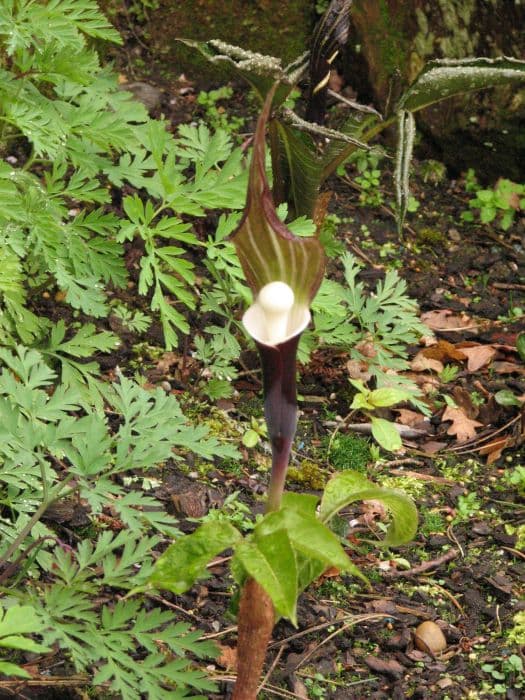Dragon Arum Dracunculus vulgaris

ABOUT
The plant known as the dragon arum has a striking and unique appearance. It features a large, purple-black spathe that unfurls to reveal a central, black spadix. The spathe is a bract or a leaf-like structure that curves gracefully, almost like a cloak, and has a rich, deep color that contrasts with the florid spadix standing upright from within. This spadix emits a notable scent that often resembles rotting meat, an adaptation for attracting the flies that pollinate it. The leaves of the dragon arum are equally dramatic; they are large and deeply cut into many segments, providing a lush, green backdrop for the dramatic bloom. This foliage has a tropical appeal, with leaves radiating out from the base of the plant in a starburst pattern, giving it a substantial and showy presence in any garden where it's found. Overall, the dragon arum presents an exotic and slightly menacing aesthetic that captures attention and curiosity.
About this plant
 Names
NamesFamily
Araceae
Synonyms
Voodoo Lily, Dragon Lily, Black Arum, Snake Lily, Stink Lily, Black Dragon, Dragonwort
Common names
Arum dracunculus, Arum dracunculus var. turcicum, Dracunculus creticus, Dracunculus canariensis, Dracunculus vulgaris var. creticus, Dracunculus vulgaris var. cyprius, Dracunculus vulgaris var. canariensis, Dragonaria dracunculus.
 Characteristics
CharacteristicsLife cycle
Perennials
Foliage type
Deciduous
Color of leaves
Green
Flower color
Purple
Height
2-5 feet (0.6-1.5 meters)
Spread
1-2 feet (0.3-0.6 meters)
Plant type
Herb
Hardiness zones
5
Native area
Mediterranean
Benefits
 General Benefits
General Benefits- Ornamental Value: Dracunculus vulgaris, commonly known as Voodoo Lily, is highly valued for its unique and dramatic flower spathes that can add an exotic touch to gardens.
- Conversation Starter: The unusual appearance of this plant, with its large, speckled spathe and tall spadix, makes it a talking point and can draw attention in a garden setting.
- Drought Tolerance: Voodoo Lily is relatively drought-resistant once established, making it suitable for xeriscaping and low-water garden designs.
- Easy Propagation: Voodoo Lily can be easily propagated through division, allowing gardeners to quickly multiply their collection or share with others.
- Pest Resilience: The strong odor emitted by its flowers can deter some pests, making it less prone to pest issues compared to other garden plants.
- Wildlife Attraction: While the scent might be off-putting to humans, it can attract pollinators like flies, which can benefit the overall health of the garden ecosystem.
 Medical Properties
Medical Properties- Anti-inflammatory: Dracunculus vulgaris has been reported to have anti-inflammatory properties, which could potentially be used for reducing inflammation.
- Analgesic: Some sources suggest that the plant may possess analgesic effects, helping to alleviate pain.
- Antirheumatic: There are indications that Dracunculus vulgaris might be used to soothe rheumatic pain.
 Air-purifying Qualities
Air-purifying QualitiesThis plant is not specifically known for air purifying qualities.
 Other Uses
Other Uses- Dragon Arum's large leaves have been used in flower arrangements to provide a green, tropical look in bouquets and decorations.
- The spadix of the Dragon Arum, which heats up during blooming, has been demonstrated in educational settings to teach about thermogenesis in plants.
- Some gardeners utilize the plant's ability to repel certain animals, as its strong odor when blooming can discourage animals from browsing nearby plants.
- The distinctive appearance of the Dragon Arum is often used in landscape design to create a focal point or conversation piece within a garden.
- Dragon Arum is sometimes used in photography projects and art installations due to its unique and dramatic structure and blooming process.
- The plant has occasionally featured in cultural festivals or garden shows that highlight exotic or unusual plants.
- Dragon Arum's striking flowers have inspired designs in fashion, from clothing patterns to jewelry, where its shape is emulated.
- Some artists and illustrators use the Dragon Arum as a subject in botanical illustrations or for fantasy-themed art due to its otherworldly appearance.
- The tuber of the Dragon Arum has been used historically as a form of starch for stiffening clothes, although this use is not common today.
- Enthusiasts of the Dragon Arum sometimes participate in seed exchange programs to spread this unusual plant among collectors and horticulturalists.
Interesting Facts
 Feng Shui
Feng ShuiThe Voodoo Lily is not used in Feng Shui practice.
 Zodiac Sign Compitability
Zodiac Sign CompitabilityThe Voodoo Lily is not used in astrology practice.
 Plant Symbolism
Plant Symbolism- Mystery and Curiosity - Dracunculus vulgaris, also known as the Dragon Arum, resembles a dragon and carries a sense of the mysterious and exotic, piquing interest and curiosity.
- Strength and Power - The "dragon" in Dragon Arum symbolizes strength and power, potentially denoting the bearer's commanding presence or fortitude.
- Bewitching Charm - The striking appearance of the plant, with its bold coloring, can represent an enchanting or bewitching allure.
- Deceptive Beauty - Despite its beauty, the Dragon Arum emits a foul odor when it blooms, representing the concept of deceptive appearances.
- Protection - In some folklore, dragons are seen as guardians, so this plant could symbolize protection against negative forces.
 Water
WaterThe Voodoo Lily should be watered thoroughly, allowing the soil to become slightly dry between waterings. Typically, water once every 7-10 days by pouring water evenly around the base of the plant, using roughly half a gallon for larger plants to ensure the soil is moist but not waterlogged. During active growth in spring and summer, the Voodoo Lily may require more frequent watering, while in winter, when the plant is dormant, water sparingly—just enough to prevent the soil from completely drying out.
 Light
LightVoodoo Lilies prefer bright, indirect light but can tolerate some direct sunlight, especially if it's the gentle morning sun. They thrive best when placed in a spot that receives dappled sunlight throughout the day or situated near a north or east-facing window where the harsh afternoon sun won't cause leaf burn.
 Temperature
TemperatureVoodoo Lilies perform best in temperatures ranging between 60 and 75 degrees Fahrenheit. They can tolerate a minimum temperature of around 50 degrees Fahrenheit, but temperatures below this range may harm the plant. They are not frost-tolerant and should be protected from extreme cold, with ideal growth occurring within the specified temperature range.
 Pruning
PruningPruning Voodoo Lilies is generally for removing spent flowers or dead foliage to maintain plant health and appearance. Prune after flowering by cutting the flower stalk down to the base of the plant. Additionally, trim away any yellowing leaves. The best time for pruning is after the blooming cycle is complete, usually in late summer or early fall.
 Cleaning
CleaningAs needed
 Soil
SoilVoodoo lily prefers a well-draining soil mix composed of 1 part peat, 1 part pine bark, and 1 part coarse sand or perlite. The soil pH should be slightly acidic to neutral, ranging from 5.5 to 7.0 for optimal growth.
 Repotting
RepottingVoodoo lily should be repotted every 2 to 3 years, or whenever it outgrows its current container, to ensure continued growth and prevent crowding of the tuber.
 Humidity & Misting
Humidity & MistingVoodoo lily thrives at average to high humidity levels, ideally between 50% and 70%, to mimic its natural habitat conditions.
 Suitable locations
Suitable locationsIndoor
Place in bright, indirect light and ensure high humidity.
Outdoor
Plant in partial shade, sheltered from strong winds.
Hardiness zone
6-9 USDA
 Life cycle
Life cycleDracunculus vulgaris, commonly known as the Dragon Arum, begins its life cycle as a tuber buried in well-drained soil. In early spring, the tuber sends up a singular, speckled stem followed by one large, divided leaf, creating a canopy above the ground. The plant blooms in late spring or early summer, producing a tall, hooded spathe that surrounds a spike-like spadix, emitting a foul odor to attract pollinating insects. After pollination, the spathe withers, and the plant develops a cluster of bright red berries in late summer, which are poisonous and should not be ingested. The foliage dies back in summer after which the plant enters a period of dormancy. The cycle begins anew when the temperatures drop, and the tuber goes dormant, waiting to sprout again the following spring.
 Propogation
PropogationPropogation time
Spring-Early Summer
Propogation: The Voodoo lily is typically propagated through division of its tubers. This is usually done after the plant has finished blooming and has died back, which is typically in the late summer or early fall. To propagate the Voodoo lily through tuber division, the tuber should be carefully dug up and any offsets or smaller tubers that have formed can be separated from the parent tuber. These smaller tubers can then be planted immediately, placing them about 4 to 6 inches (10 to 15 centimeters) deep in well-drained soil. It's important to handle the tubers with care as they can be delicate. Once planted, the tuber should start to grow the following spring, producing its striking foliage and unique flowers. This method is favored for its simplicity and effectiveness in producing clones of the parent plant.









